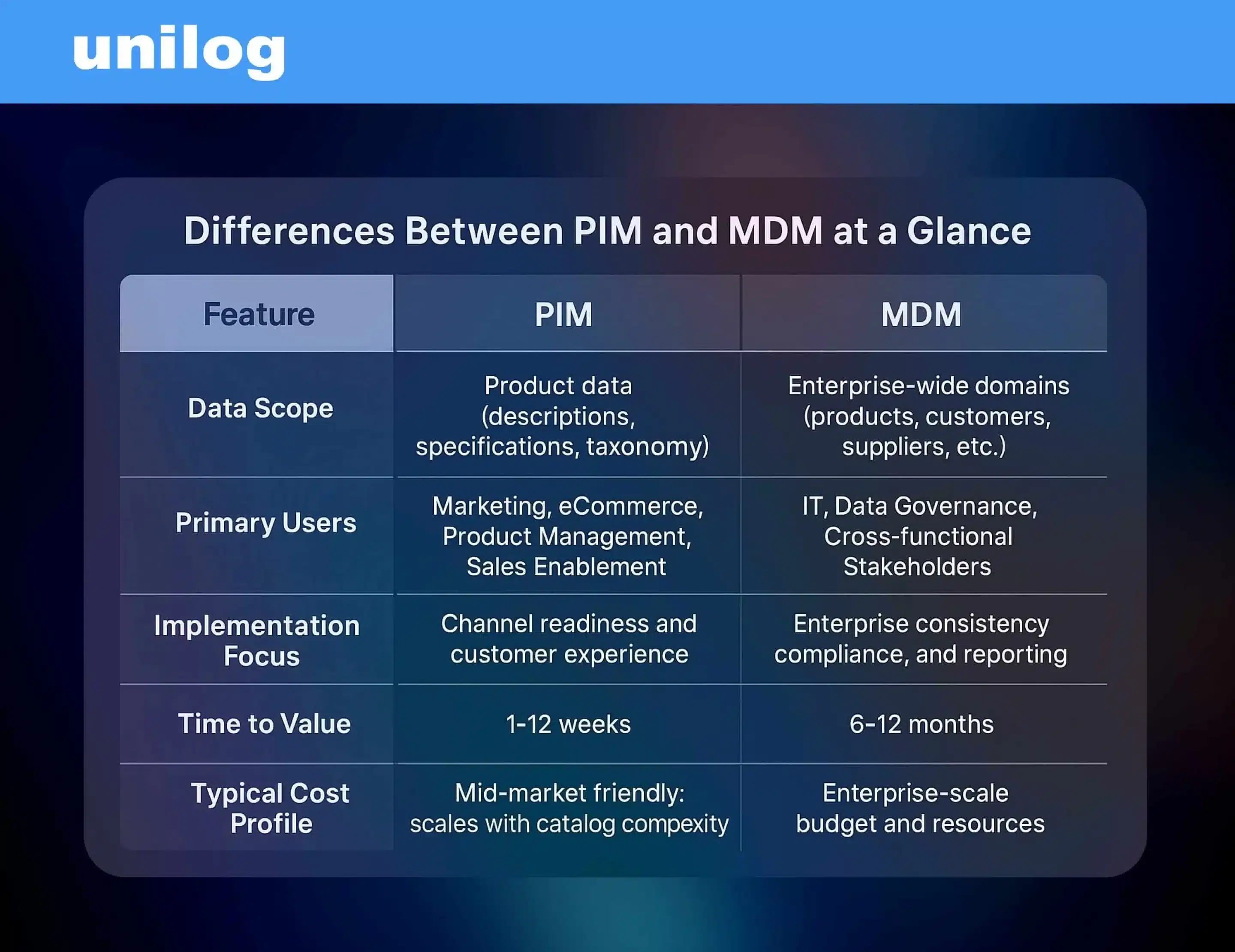Understanding the Basics: PIM and MDM Defined
What is Product Information Management (PIM)?
Product Information Management (PIM) centralizes, enriches, and distributes product data from a single, authoritative source. For distributors and manufacturers with complex catalogs (often tens of thousands of SKUs), a PIM system enables the storage of this rich data, including detailed attributes, technical specifications, a product taxonomy, and much more, and then can be configured to syndicate the content consistently to eCommerce storefronts, ERPs, digital catalogs, and sales teams. The outcome is accurate, complete, and channel-ready product information that supports product findability, comparison, and confident buying decisions.
What is Master Data Management (MDM)?
Master Data Management (MDM) governs data across multiple domains (e.g., products, customers, suppliers, locations, employees, financials, and more) creating enterprise-wide consistency. Its aim is to establish trusted “golden records” that align applications, processes, and reporting. Compared to PIM’s product-first focus, MDM is broader and typically IT-led, with data governance structures that span departments and systems to enable compliance, analytics, and operational integrity. MDM may be implemented with a large enterprise-level singular system, or more commonly implemented as strong integrations across a handful of domain specific management tools, with a PIM system being a primary application.
Differences Between PIM and MDM at a Glance
Key Differences…That Matter for Organizations
Data Scope: Products vs. Enterprise-Wide
For distributors and manufacturers, competitive advantage often hinges on product depth: complete attributes, compatibility, certifications, digital assets and variant relationships. PIM systems are purpose-built for this depth, providing the structure to govern attributes, normalize item data, and maintain category-specific rules. MDM includes product data but must also cover other domains; its breadth is valuable, yet it is rarely optimized for the nuanced product detail required to power merchandising and eCommerce on its own.
Primary Users: Marketing/Sales vs. Organization-Wide
In a PIM, day-to-day users are marketers, product managers, merchandisers, and eCommerce operators, the teams accountable for how SKUs are presented and discovered. In MDM, the user base spans finance, operations, HR, supply chain, compliance, and analytics, reflecting MDM’s broader mission to harmonize data across the organization.
Implementation: Business-Led vs. IT-Led
PIM programs typically originate with commercial teams seeking faster launches, richer product pages, and higher conversion. That business-led charter translates to shorter timelines and clear, revenue-adjacent outcomes. MDM initiatives are usually driven by IT and governance, requiring cross-functional policy decisions, stewardship roles, and shared quality standards. Important work, but inherently heavier to stand up and socialize across the enterprise.
Time-to-Value: Weeks/Months vs. Months/Years
Mid-market companies commonly realize PIM benefits within a single quarter: faster SKU onboarding, better on-site search and filtering, fewer product-data support tickets, and more consistent content across channels. MDM’s returns accrue after foundational work such as domain modeling, stewardship, and data quality processes, so the horizon is longer but enables durable cross-enterprise consistency.
Cost Considerations for Distributors and Manufacturers
Because PIM focuses on product data and adjacent workflows, total cost aligns with catalog size, attribute complexity, and integration needs. MDM projects span more systems and stakeholders, requiring larger budgets and dedicated governance resources. Many mid-market organizations start with PIM to capture near-term ROI and operational wins before expanding toward MDM.
B2B Industry-Specific Challenges
Managing Complex Product Catalogs
Distributors in industries like electrical, plumbing, HVAC, PVF, and industrial supplies manage deep catalogs with rich attribute taxonomies and multi-level relationships (assemblies, alternates, equivalents, and kits). PIM enforces structure, normalizes supplier feeds, and streamlines enrichment so product growth doesn’t stall operations or confuse customers.
Handling Technical Specifications and Attributes
B2B buyers rely on precise details like dimensions, materials, standards, performance ranges, and compliance statements. PIM provides governance for attributes and validation rules, ensuring each SKU meets data-completeness thresholds that reduce returns, minimize quoting errors, and increase buyer confidence.
Supporting Multiple Sales Channels
Inside sales, branches, marketplaces, print/digital catalogs, and eCommerce all require consistent product truth. PIM orchestrates omnichannel syndication, so product information remains synchronized as items evolve and assortments expand.
Supplier Data Integration Requirements
Supplier-provided data arrives in varied formats and with inconsistent quality. PIM centralizes ingestion, mapping, de-duplication, and normalization, accelerating onboarding while preserving data integrity and reducing manual effort.
When to Choose PIM for Your Business
Signs Your Distribution Business Needs PIM
If product updates live in spreadsheets, launch dates slip because attributes aren’t ready, or eCommerce search returns incomplete results, PIM is likely the right first step. Another signal is when teams spend more time wrangling content than launching it; PIM turns that bottleneck into a governed workflow.
How Manufacturers Benefit from PIM
Manufacturers use PIM to publish a single, brand-accurate product narrative to every channel and partner, minimizing downstream content drift. Strong PIM discipline ensures distributors and resellers present the right specifications and collateral across regional and channel variations.
Common PIM Implementation Scenarios
Typical scenarios include launching or relaunching eCommerce, consolidating fragmented product sources, onboarding large supplier assortments quickly, and establishing attribute governance for complex lines. PIM provides the framework to execute each scenario predictably, with clear roles and quality thresholds.
ROI Timeline for PIM in B2B
PIM projects in mid-market B2B commonly reach positive ROI within 6–12 months, driven by faster SKU onboarding, lower manual rework, improved on-site search/filter accuracy, higher conversion from richer content, reduced customer service inquiries, and fewer order-entry issues linked to poor data.
When MDM Makes Sense for Organizations
Enterprise-Wide Data Governance Requirements
If auditability, lineage, and cross-domain stewardship are paramount, for example, regulated reporting or standardized analytics, MDM delivers governance that a PIM alone does not address. It sets enterprise policies and enforces consistency at scale.
Multi-Domain Data Management Needs
Organizations operating multiple ERPs or business units often need unified customers, suppliers, and locations in addition to products. MDM harmonizes these domains so planning, pricing, and operations work coherently across entities and regions.
Long-Term Digital Transformation Strategy
When data is a strategic asset beyond commerce, fueling forecasting, supply-chain optimization, and financial controls, MDM’s golden records and quality programs provide a durable foundation for enterprise decision-making.
Mergers and Acquisitions Considerations
The integration of new business units via mergers and acquisitions can introduce duplicate records, conflicting codes, and incompatible hierarchies. MDM provides the methodology to reconcile, master, and govern cross-domain data post-integration, reducing operational risk and accelerating synergies.
Creating a Strategic Roadmap: PIM, MDM, or Both?
Starting with PIM: The Practical Approach
Most organizations begin with PIM because it solves the most visible, revenue-adjacent pain: getting product information right, fast, and everywhere it needs to be. PIM becomes the day-to-day nucleus of product truth and the engine for channel readiness; tangible wins that build momentum and internal support.
Building Toward MDM
As data maturity grows, organizations layer in MDM to extend governance from product into customer and supplier domains. This phased trajectory lowers risk, delivers measurable value at each step, and readies the enterprise for standardized analytics and process consistency.
How Leading Distributors Are Combining Both Solutions
A common pattern is PIM handling product-specific depth while MDM masters cross-domain entities. PIM feeds enriched product records downstream; MDM, in turn, harmonizes products alongside customers and suppliers for enterprise reporting and compliance.
Implementation Best Practices
Define ownership early (who stewards which attributes, who approves taxonomy changes, etc.), align KPIs to business outcomes (time-to-launch, conversion, call-deflection), and treat integrations as first-class workstreams with clear requirements for ERP and eCommerce. Establish data quality rules that prevent incomplete items from being published and publish a change-management plan so adoption sticks.
Evaluating PIM and MDM Solutions for Your Business
Key Questions to Ask Vendors
As you evaluate potential solutions, it’s important to dig deeper into how each vendor supports your business needs and long-term goals. Which domains does the solution specialize in, and how are those domains modeled? What governance features exist—validation, workflows, versioning, and audit trails? How are channel outputs handled for eCommerce and downstream systems? What does day-to-day stewardship look like for business users?
Must-Have Features for B2B Organizations
For B2B, robust attribute modeling, variant/kit/bundle support, supplier feed onboarding, validation rules, and workflow approvals are table stakes. Look for strong taxonomy management, an integrated digital asset management solution, completeness scoring, and publishing controls that help teams move faster without sacrificing quality. Reporting on data health and content coverage should be built-in, not an afterthought.
Integration Considerations
The true value of a PIM or MDM solution shows up in how well it connects with the systems you rely on every day. Look at how the PIM maps to ERP item masters and price/availability data, how enriched content is published to your storefront, and how change events are handled. If MDM is on your roadmap, define how PIM’s product truth will merge into MDM and how MDM will harmonize product, customer, and supplier domains for analytics and compliance.
Measuring Success
To understand whether your PIM or MDM investment is paying off, you need to connect performance metrics to real business outcomes. Tie metrics to business outcomes: SKU time-to-market, attribute completeness by category, search refinements and success rate, conversion lift on enriched SKUs, and support-ticket reduction. These measures provide early proof of value for PIM and create baselines for any future MDM expansion.
Take the Next Step with Unilog
If your near-term goal is impact, start where customers see it first: getting accurate, enriched product content to every channel. A syndication-first approach lets you move now and mature your data strategy over time. Unilog’s CX1 PIM helps teams publish consistent product information wherever buyers shop and fits cleanly alongside your current stack, or can serve as a pragmatic starting point while you build.
Ready to Learn More?

